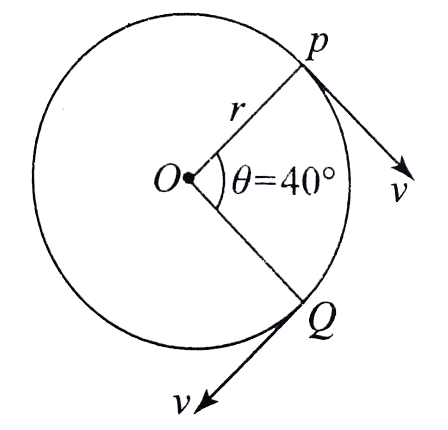A particle is moving with a uniform speed v in a circular path of radius r with the centre at 0. When the particle moves from a point P to Q on the circle such that ∠POQ=θ , then the magnitude of the change in velocity is
2vsin(2θ)
zero
2vsin(θ)2
2vcosθ(θ2)
The correct Answer is:C
To find the magnitude of the change in velocity of a particle moving along a circular path when it moves from point P to point Q, we can follow these steps:
1. Understand the Problem:
The particle is moving with a uniform speed v in a circular path of radius r. The angle ∠POQ=θ is given, where O is the center of the circle, P is the initial position, and Q is the final position.
2. Identify Initial and Final Velocities:
Since the particle is moving in a circular path, at point P, the velocity vector →v1 is tangent to the circle at that point. Similarly, at point Q, the velocity vector →v2 is also tangent to the circle at that point. Both velocities have the same magnitude v.
3. Determine the Angle Between the Velocity Vectors:
The angle between the two velocity vectors →v1 and →v2 is equal to θ because both vectors are tangent to the circle and the angle ∠POQ subtended at the center is θ.
4. Use the Formula for Change in Velocity:
The change in velocity Δ→v can be calculated using the formula:
|Δ→v|=|→v2−→v1|
Using the law of cosines:
|Δ→v|=√|→v1|2+|→v2|2−2|→v1||→v2|cos(θ)
Since |→v1|=|→v2|=v:
|Δ→v|=√v2+v2−2v2cos(θ)
|Δ→v|=√2v2(1−cos(θ))
5. Simplify the Expression:
Factor out v2:
|Δ→v|=v√2(1−cos(θ))
6. Use the Trigonometric Identity:
We can use the identity 1−cos(θ)=2sin2(θ2):
|Δ→v|=v√2⋅2sin2(θ2)
|Δ→v|=v⋅2sin(θ2)
7. Final Result:
Therefore, the magnitude of the change in velocity is:
|Δ→v|=2vsin(θ2)
The particle is moving with a uniform speed v in a circular path of radius r. The angle ∠POQ=θ is given, where O is the center of the circle, P is the initial position, and Q is the final position.
Since the particle is moving in a circular path, at point P, the velocity vector →v1 is tangent to the circle at that point. Similarly, at point Q, the velocity vector →v2 is also tangent to the circle at that point. Both velocities have the same magnitude v.
The angle between the two velocity vectors →v1 and →v2 is equal to θ because both vectors are tangent to the circle and the angle ∠POQ subtended at the center is θ.
The change in velocity Δ→v can be calculated using the formula:
|Δ→v|=|→v2−→v1|
Using the law of cosines:
|Δ→v|=√|→v1|2+|→v2|2−2|→v1||→v2|cos(θ)
Since |→v1|=|→v2|=v:
|Δ→v|=√v2+v2−2v2cos(θ)
|Δ→v|=√2v2(1−cos(θ))
Factor out v2:
|Δ→v|=v√2(1−cos(θ))
We can use the identity 1−cos(θ)=2sin2(θ2):
|Δ→v|=v√2⋅2sin2(θ2)
|Δ→v|=v⋅2sin(θ2)
Therefore, the magnitude of the change in velocity is:
|Δ→v|=2vsin(θ2)
Topper's Solved these Questions
- LAWS OF MOTION BOOK - MTG-WBJEECHAPTER - LAWS OF MOTION EXERCISE - WB JEE PREVIOUS YEARS QUESTIONS (CATEGORY 2: SINGLE OPTION CORRECT TYPE (2 MARKS))
1 Videos
- LAWS OF MOTION BOOK - MTG-WBJEECHAPTER - LAWS OF MOTION EXERCISE - WB JEE PREVIOUS YEARS QUESTIONS (CATEGORY 3: ONE OR MORE THAN ONE OPTION CORRECT TYPE (2 MARKS))
2 Videos
- LAWS OF MOTION BOOK - MTG-WBJEECHAPTER - LAWS OF MOTION EXERCISE - WB JEE WORKOUT (CATEGORY 3: ONE OR MORE THAN ONE OPTION CORRECT TYPE (2 MARKS))
10 Videos
- KINETIC THEORY OF GASES BOOK - MTG-WBJEECHAPTER - KINETIC THEORY OF GASES EXERCISE - WB JEE PREVIOUS YEARS QUESTIONS (MCQ)
7 Videos
- MAGNETIC EFFECT OF CURRENTBOOK - MTG-WBJEECHAPTER - MAGNETIC EFFECT OF CURRENTEXERCISE - WB JEE Previous Years Questions
22 Videos
Similar Questions
Knowledge Check
A particle moving in a circular path of radius (r) with velocity (V), Then centripetal acceleration of the particle is
AV2rBrV2CVrDV2rA particle moving in a circular path of radius (r) with velocity (V), Then centripetal acceleration of the particle is
AV2rBrV2CVrDV2r
A particle is moving on a circular path of radius r with uniform velocity v. The change in velocity when the particle moves from P to Q is (∠POQ=40∘)A2vcos40∘B2vsin40∘C2vsin20∘D2vcos20∘
A particle is moving on a circular path of radius R with constant speed v. During motion of the particle form point A to point B

View SolutionA particle moves with constant speed v along a circular path of radius r and completes the circle in time T. The acceleration of the particle is
View SolutionA particle of mass m is moving on a circular path of radius r with uniform speed v , rate of change of linear momentum is
View SolutionA particle moves with uniform speed in a circular path the angle between instantaneous velocity and acceleration is
View SolutionA Particle of mass 'M' moves in a uniform circular path of radius 'r' with a constant speed 'v' then its centripetal acceleration is .
View Solution
